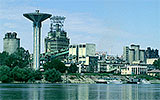AEWS
Accident Emergency Warning System
The Accident Emergency Warning System (AEWS) is activated whenever there is a risk of transboundary water pollution, or threshold danger levels of hazardous substances are exceeded. The AEWS sends out international warning messages to countries downstream. This helps the authorities to put environmental protection and public safety measures into action.
Did you know?
At present, the AEWS only deals with accidental spills, but there are already plans for ice and flood warnings to be included in the system.
The system underwent a major test in 2000, during the Baia Mare and Baia Borsa spill accidents on the Tisa River. The system effectively enabled the timely activation of measures that prevented more extensive damage to people and ecosystems downstream along the Tisa River.
The AEWS operates on a network of Principal International Alert Centres in each of the participating countries. These centres are made up of three basic units:
- Communication Unit (operating 24 hours a day), which sends and receives warning messages
- Expert Unit, which evaluates the possible transboundary impact of any accident using the database of dangerous substances and the Danube Basin Alarm Model
- Decision Unit, which decides when international warnings are to be sent
The first stage of the AEWS came into operation in April 1997 in Austria, Bulgaria, Czech Republic, Croatia, Germany, Hungary, Romania, Slovakia and Slovenia. Ukraine and Moldova entered the system in 1999; and Bosnia and Herzegovina and the Republic of Serbia are on board since 2005.
An essential improvement of AEWS was carried out in 2003/2004 with support of the UNDP/GEF Danube Regional Project. The goal of this upgrade was to increase the effectiveness and cost-efficiency of the warning system by replacing the satellite communication with an internet-based information system using GSM/SMS messages for alerting the PIAC staff. A test performed in June 2004 has proven that the system works as expected. Consequently, the AEWS was upgraded to an internet-based information system.
Between May 1997 and September 2003, the system registered 35 accidents. Almost half the incidents involved oil pollution, and in 12 cases the origins of the pollution were identified.
In 2006 the AEWS transmitted information on eight accidents:
| Site and Date of Accident | Affected River | Primary Pollutant |
| Petronell (Austria) 14.01.2006
|
Danube, rkm 1891 to 1889
|
Mineral oil
|
| Danube upstream Melk (Austria) 03.03.2006
|
Danube, rkm 2072 to 2042
|
Mineral oil
|
| Smederevo (Serbia) 03.04.2006
|
Danube, rkm 1112.2 to 1112
|
Mineral oil
|
| Jamena (Serbia) 17.06.2006
|
Sava, rkm 196 to 176
|
Atrazine
|
| Bratislava (Slovakia) 28.06.2006
|
Danube at Bratislava
|
Mineral oil
|
| Prahovo (Serbia) 02.10.2006
|
Danube, rkm 849 to 855
|
Mineral oil
|
| Bulgarian Danube 07.12.2006
|
Danube, rkm 824 to 817
|
Mineral oil
|
| Bulgarian Danube 22.12.2006
|
Danube, rkm 790
|
Mineral oil
|

Principal International Alert Centres in the Danube River Basin
Disclaimer
The information contained in the ICPDR website is intended to enhance public access to information about the ICPDR and the Danube River. The information is correct to the best of the knowledge of the ICPDR Secretariat. If errors are brought to our attention we will try to correct them.
The ICPDR, expert group members, nor other parties involved in preparation of information contained on this website cannot, however, be held responsible for the correctness and validity of the data and information provided, nor accept responsibility or liability for damages or losses arising directly or indirectly from the use of the information conveyed therein.
Only those documents clearly marked ICPDR documents reflect the position of the ICPDR.
Any links to other websites are provided for your convenience only. The ICPDR does not accept any responsibility for the accuracy, availability, or appropriateness to the user's purposes, of any information or services on any other website.
When using the information and material provided on this website, credit should be given to the ICPDR.

